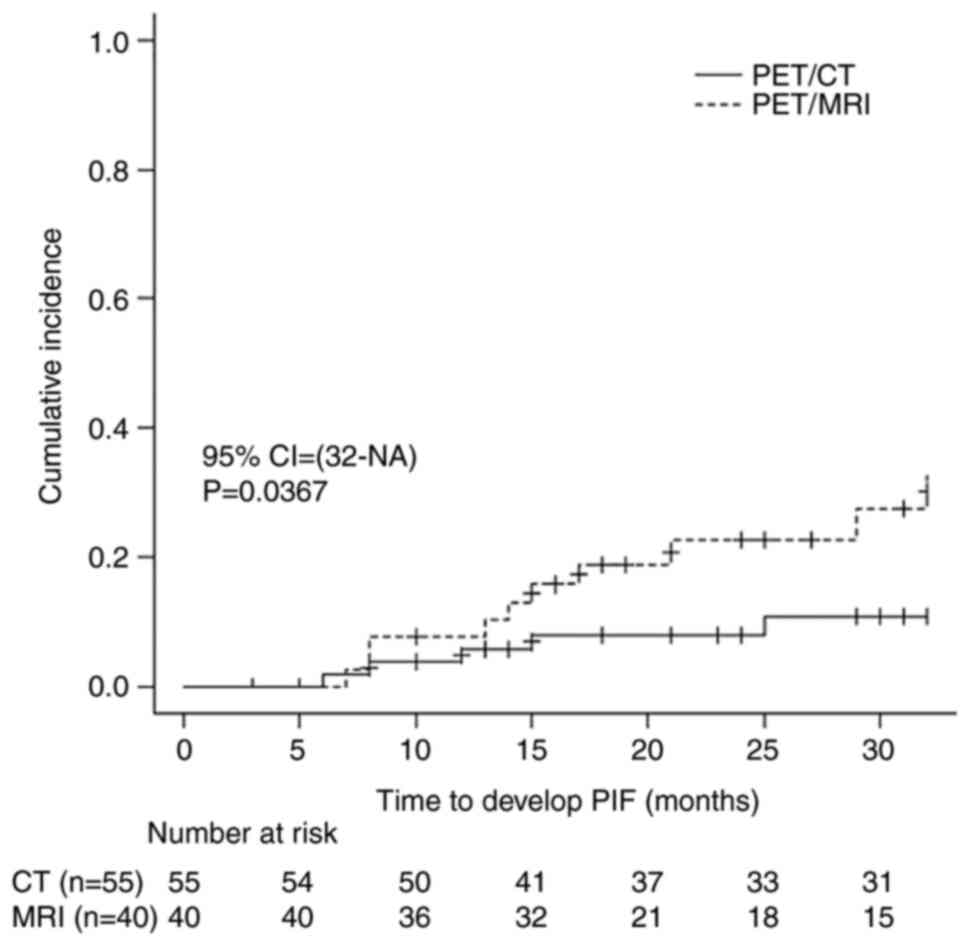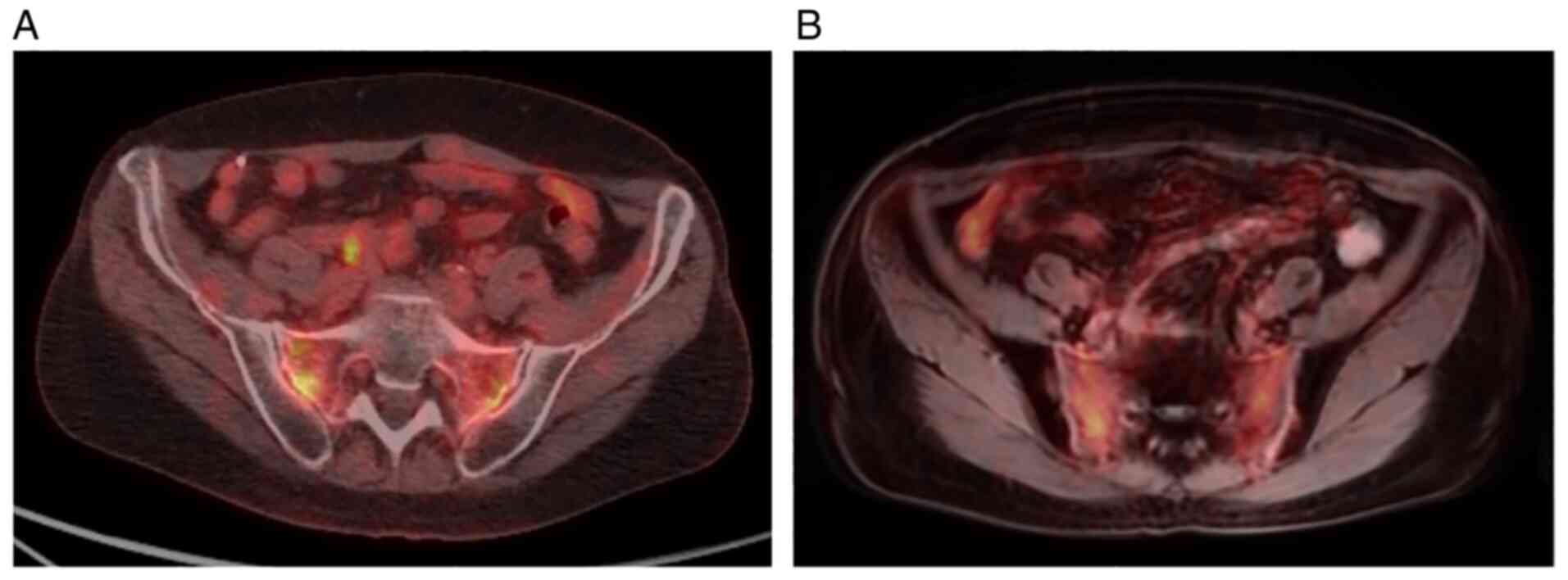|
1
|
Klaitong C, Meannuch E, Kaewbunperm U,
Klaiphibule P and Sinthusek T: EP-1512: Radiotherapy at pelvis
region in menopausal cervix cancer induce osteopenia/osteoporosis.
Radiother Oncol. 127 (Suppl 1):S819–S820. 2018. View Article : Google Scholar
|
|
2
|
Small W Jr and Kachnic L: Postradiotherapy
pelvic fractures cause for concern or opportunity for future
research? JAMA. 294:2635–2637. 2005. View Article : Google Scholar : PubMed/NCBI
|
|
3
|
Viswanathan AN, Lee LJ, Eswara JR,
Horowitz NS, Konstantinopoulos PA, Mirabeau-Beale KL, Rose BS, Von
Keudell AG and Wo JY: Complications of pelvic radiation in patients
treated for gynecologic malignancies. Cancer. 120:3870–3883. 2014.
View Article : Google Scholar : PubMed/NCBI
|
|
4
|
Sapienza LG, Salcedo MP, Ning MS, Jhingran
A, Klopp AH, Calsavara VF, Schmeler KM, Leite Gomes MJ, de Freitas
Carvalho E and Baiocchi G: Pelvic insufficiency fractures after
external beam radiation therapy for gynecologic cancers: A
meta-analysis and meta-regression of 3929 patients. Int J Radiat
Oncol Biol Phys. 106:475–484. 2020. View Article : Google Scholar : PubMed/NCBI
|
|
5
|
Park S, Kim J, Lee J and Park IK: Pelvic
insufficiency fracture after radiotherapy in patients with cervical
cancer in the era of PET/CT. Radiat Oncol J. 29:269–276. 2011.
View Article : Google Scholar : PubMed/NCBI
|
|
6
|
Ramlov A, Pedersen EM, Røhl L, Worm E,
Fokdal L, Lindegaard JC and Tanderup K: Risk factors for pelvic
insufficiency fractures in locally advanced cervical cancer
following intensity modulated radiation therapy. Int J Radiat Oncol
Biol Phys. 97:1032–1039. 2017. View Article : Google Scholar : PubMed/NCBI
|
|
7
|
Bazire L, Xu H, Foy JP, Amessis M,
Malhaire C, Cao K, De La Rochefordiere A and Kirova YM: Pelvic
insufficiency fracture (PIF) incidence in patients treated with
intensity-modulated radiation therapy (IMRT) for gynaecological or
anal cancer: Single-institution experience and review of the
literature. Br J Radiol. 90:201608852017. View Article : Google Scholar : PubMed/NCBI
|
|
8
|
Cai ZX, Li Y, Yang ZH, Gong S, Zhang MD
and Chen JY: MRI and associated clinical characteristics of pelvic
insufficiency fracture in cervical carcinoma patients after
radiation therapy. Chinese J Med Imaging Technol. 31:1483–1486.
2015.
|
|
9
|
Tokumaru S, Toita T, Oguchi M, Ohno T,
Kato S, Niibe Y, Kazumoto T, Kodaira T, Kataoka M, Shikama N, et
al: Insufficiency fractures after pelvic radiation therapy for
uterine cervical cancer: An analysis of subjects in a prospective
multi-institutional trial, and cooperative study of the Japan
radiation oncology group (JAROG) and Japanese radiation oncology
Study Group (JROSG). Int J Radiat Oncol Biol Phys. 84:e195–e200.
2012. View Article : Google Scholar : PubMed/NCBI
|
|
10
|
Schmeler KM, Jhingran A, Iyer RB, Sun CC,
Eifel PJ, Soliman PT, Ramirez PT, Frumovitz M, Bodurka DC and Sood
AK: Pelvic fractures after radiotherapy for cervical cancer:
Implications for survivors. Cancer. 116:625–630. 2010. View Article : Google Scholar : PubMed/NCBI
|
|
11
|
Oh D, Huh SJ, Park W, Ju SG, Nam H and Lee
JE: Clinical outcomes in cervical cancer patients treated by
FDG-PET/CT-based 3-dimensional planning for the first brachytherapy
session. Medicine (Baltimore). 95:e38952016. View Article : Google Scholar : PubMed/NCBI
|
|
12
|
Yamamoto K, Nagao S, Suzuki K, Kogiku A,
Senda T, Yano H, Kitai M, Shiozaki T, Matsuoka K and Yamaguchi S:
Gynecologic Oncology Pelvic fractures after definitive and
postoperative radiotherapy for cervical cancer: A retrospective
analysis of risk factors. Gynecol Oncol. 147:585–588. 2017.
View Article : Google Scholar : PubMed/NCBI
|
|
13
|
Weidenbacher B, Borm K and Oechsner M:
Pelvic fractures after radiotherapy for cervical cancer.
Strahlenther Onkol. 194:2018.
|
|
14
|
Shih KK, Folkert MR, Kollmeier MA,
Abu-Rustum NR, Sonoda Y, Leitao MM, Barakat RR and Alektiar KM:
Pelvic insufficiency fractures in patients with cervical and
endometrial cancer treated with postoperative pelvic radiation.
Gynecol Oncol. 128:540–543. 2013. View Article : Google Scholar : PubMed/NCBI
|
|
15
|
Ta L, Jt G, Se D, Cc H and Hjn A: Effects
of pelvic radiotherapy for primary pelvic cancers (Review).
Cochrane Database Syst Rev. 2018.
|
|
16
|
Elit L and Reade CJ: Recommendations for
follow-up care for gynecologic cancer survivors. Obstet Gynecol.
126:1207–1214. 2015. View Article : Google Scholar : PubMed/NCBI
|
|
17
|
Mehmood Q, Beardwood M, Swindell R,
Greenhalgh S, Wareham T, Barraclough L, Livsey J and Davidson SE:
Insufficiency fractures in patients treated with pelvic
radiotherapy and chemotherapy for uterine and cervical cancer. Eur
J Cancer Care (Engl). 23:43–50. 2014. View Article : Google Scholar : PubMed/NCBI
|
|
18
|
Kuji S, Hirashima Y, Komeda S, Tanaka A,
Abe M, Takahashi N, Takekuma M, Asakura H, Harada H and Nishimura
T: Feasibility of extended-field irradiation and intracavitary
brachytherapy combined with weekly cisplatin chemosensitization for
IB2-IIIB cervical cancer with positive paraaortic or high common
iliac lymph nodes: A retrospective review. Int J Clin Oncol.
19:341–347. 2014. View Article : Google Scholar : PubMed/NCBI
|
|
19
|
Jung J, Park G and Kim YS: Definitive
extended-field intensity-modulated radiotherapy with chemotherapy
for cervical cancer with para-aortic nodal metastasis. Anticancer
Res. 34:4361–4366. 2014.PubMed/NCBI
|
|
20
|
Uezono H, Tsujino K, Ota Y, Nagano F,
Soejima T, Moriki K and Sasaki R: Pelvic insufficiency fracture
after definitive radiotherapy for uterine cervical cancer:
Retrospective analysis of risk factors. J Radiat Res. 54:1102–1109.
2013. View Article : Google Scholar : PubMed/NCBI
|
|
21
|
Kim J, Lee KJ, Park KR, Ha B, Kim YJ, Jung
W, Lee R, Kim SC, Moon HS, Ju W, et al: Treatment outcomes after
adjuvant radiotherapy following surgery for patients with stage I
endometrial cancer. Radiat Oncol J. 34:265–272. 2016. View Article : Google Scholar : PubMed/NCBI
|
|
22
|
Lapina O and Tiškevičius S: Sacral
insufficiency fracture after pelvic radiotherapy: A diagnostic
challenge for a radiologist. Med. 50:249–254. 2014.PubMed/NCBI
|
|
23
|
NCCN clinical practice guidelines in
oncology, . Cervical Cancer Version 4. Natl Compr Cancer Netw.
2019.
|
|
24
|
Pecorelli S, Zigliani L and Odicino F:
Revised FIGO staging for carcinoma of the cervix. Int J Gynecol
Obstet. 105:107–108. 2009. View Article : Google Scholar : PubMed/NCBI
|
|
25
|
Von Elm E, Altman DG, Egger M, Pocock SJ,
Gøtzsche PC and Vandenbrouckef JP; STROBE Initiative, : The
Strengthening the Reporting of Observational Studies in
Epidemiology (STROBE) Statement: Guidelines for reporting
observational studies. Bull World Health Organ. 85:867–872. 2007.
View Article : Google Scholar : PubMed/NCBI
|
|
26
|
Halaç M, Mut SS, Sönmezoglu K, Ylmaz MH,
Ozer H and Uslu I: Avoidance of misinterpretation of an FDG
positive sacral insufficiency fracture using PET/CT scans in a
patient with endometrial cancer: A case report. Clin Nucl Med.
32:779–781. 2007. View Article : Google Scholar : PubMed/NCBI
|
|
27
|
Salavati A, Shah V, Wang ZJ, Yeh BM,
Costouros NG and Coakley FV: F-18 FDG PET/CT findings in
postradiation pelvic insufficiency fracture. J Clin Imaging.
35:139–142. 2011. View Article : Google Scholar : PubMed/NCBI
|
|
28
|
Chung YK, Lee YK, Yoon BH, Suh DH and Koo
KH: Pelvic insufficiency fractures in cervical cancer after
radiation therapy: A meta-analysis and review. In Vivo (Brooklyn).
35:1109–1115. 2021. View Article : Google Scholar : PubMed/NCBI
|
|
29
|
Ogino I, Okamoto N, Ono Y, Kitamura T and
Nakayama H: Pelvic insufficiency fractures in postmenopausal woman
with advanced cervical cancer treated by radiotherapy. Radiother
Oncol. 68:61–67. 2003. View Article : Google Scholar : PubMed/NCBI
|
|
30
|
Kwon JW, Huh SJ, Yoon YC, Choi SH, Jung
JY, Oh D and Choe BK: Pelvic bone complications after radiation
therapy of uterine cervical cancer: Evaluation with MRI. AJR Am J
Roentgenol. 191:987–994. 2008. View Article : Google Scholar : PubMed/NCBI
|
|
31
|
Kido A, Yoshida S, Shimoda E, Ishida Y,
Hasegawa M, Kobayashi H, Honoki K, Horikawa H and Tanaka Y: Walking
disability in patients with pelvic insufficiency fracture after
radiotherapy for uterine cervical cancer. Prog Rehabil Med.
1:201600092016. View Article : Google Scholar : PubMed/NCBI
|
|
32
|
Thapa N, Maharjan M, Xiong Y, Jiang D,
Nguyen TP, Petrini MA and Cai H: Impact of cervical cancer on
quality of life of women in Hubei, China. Sci Rep. 8:119932018.
View Article : Google Scholar : PubMed/NCBI
|
|
33
|
van den Blink QU, Garcez K, Henson CC,
Davidson SE and Higham CE: Pharmacological interventions for the
prevention of insufficiency fractures and avascular necrosis
associated with pelvic radiotherapy in adults. Cochrane Database
Syst Rev. 4:CD0106042018.PubMed/NCBI
|
|
34
|
Choi HJ, Ju W, Myung SK and Kim Y:
Diagnostic performance of computer tomography, magnetic resonance
imaging, and positron emission tomography or positron emission
tomography/computer tomography for detection of metastatic lymph
nodes in patients with cervical cancer: Meta-analysis. Cancer Sci.
101:1471–1479. 2010. View Article : Google Scholar : PubMed/NCBI
|
|
35
|
Pantola S, Kala S, Kala C, Sampath S and
Shukla M: Comparative study of positron emission
tomography/computed tomography and computed tomography in the
evaluation of post-treatment carcinoma cervix patients. Indian J
Nucl Med. 33:194–201. 2018.PubMed/NCBI
|
|
36
|
Broski SM, Goenka AH, Kemp BJ and Johnson
GB: Clinical PET/MRI: 2018 update. AJR Am J Roentgenol.
211:295–313. 2018. View Article : Google Scholar : PubMed/NCBI
|
|
37
|
Rosenkrantz AB, Friedman K, Chandarana H,
Melsaether A, Moy L, Ding YS, Jhaveri K, Beltran L and Jain R:
Current status of hybrid PET/MRI in oncologic imaging. Am J
Roentgenol. 206:162–172. 2016. View Article : Google Scholar : PubMed/NCBI
|
|
38
|
Schwartz M, Gavane SC, Bou-Ayache J, Kolev
V, Zakashansky K, Prasad-Hayes M, Taouli B, Chuang L and Kostakoglu
L: Feasibility and feasibility and diagnostic performance of hybrid
pet/mri compared with pet/ct for gynecological malignancies: A
prospective pilot study. Abdom Radiol. 43:3462–3467. 2018.
View Article : Google Scholar : PubMed/NCBI
|
|
39
|
Ugurluer G, Akbas T, Arpaci T, Ozcan N and
Serin M: Bone complications after pelvic radiation therapy:
Evaluation with MRI. J Med Imaging Radiat Oncol. 58:334–340. 2014.
View Article : Google Scholar : PubMed/NCBI
|
|
40
|
He X, Zhao L, Guo X, Zhao L, Wu J, Huang
J, Sun L, Xie C and Chen H: Differential diagnostic value of18F-FDG
PET/CT for benign and malignant vertebral compression fractures:
Comparison with magnetic resonance imaging. Cancer Manag Res.
10:2105–2115. 2018. View Article : Google Scholar : PubMed/NCBI
|
|
41
|
Mauch JT, Carr CM, Cloft H and Diehn FE:
Review of the imaging features of benign osteoporotic and malignant
vertebral compression fractures. AJNR Am J Neuroradiol.
39:1584–1592. 2018. View Article : Google Scholar : PubMed/NCBI
|
|
42
|
Grangier C, Garcia J, Howarth NR, May M
and Rossier P: Role of MRI in the diagnosis of insufficiency
fractures of the sacrum and acetabular roof. Skeletal Radiol.
26:517–524. 1997. View Article : Google Scholar : PubMed/NCBI
|

















